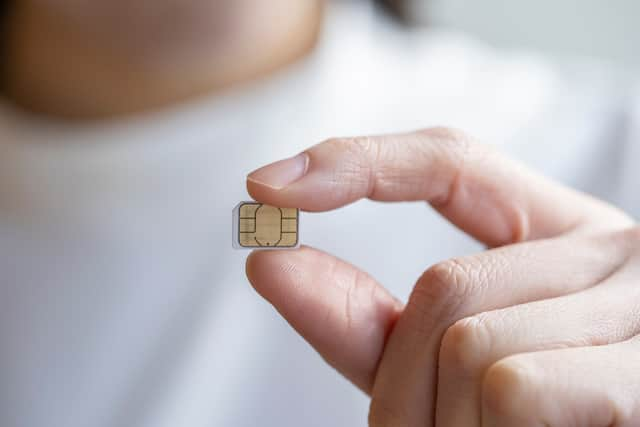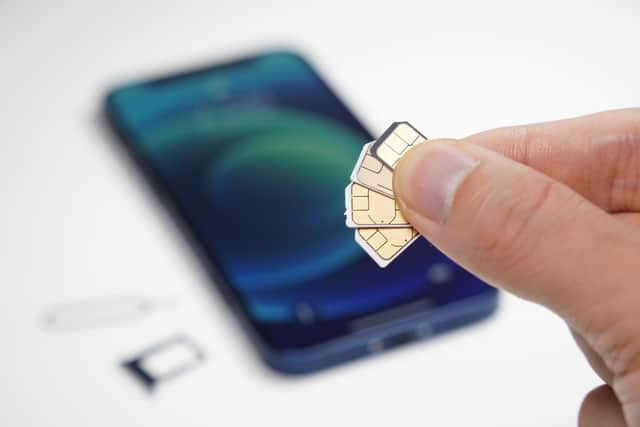Sim-swap scam: Action Fraud advice explained, what is crime, is it on the rise - how to spot and report it
and live on Freeview channel 276
Scams have been on the rise over the last 12 months as criminals have sought to exploit the cost of living crisis.
Several tactics are being employed by fraudsters ranging from simpler scams, like phishing, to much more complicated ones, such as authorised push payments. Forms of attack that are particularly on the rise include those related to online shopping and housing issues.
Advertisement
Hide AdAdvertisement
Hide AdOne recent warning came from high street bank Lloyds and related to advance fee payments. This type of crime sees people get conned into paying upfront for goods and services that then don’t materialise.
Another popular form of scam is sim-swap fraud. This crime soared by 400% between 2015 and 2020.
But how exactly does it work - and what should you do if you get caught out?


What is a sim-swap scam?
Also known as ‘sim splitting’, this type of scam basically involves a fraudster tricking your mobile network provider into giving them your phone number. The benefit to them of doing this is that they will receive all of your one-time passcodes, which can enable them to access everything from your bank account to your social media profiles.
Advertisement
Hide AdAdvertisement
Hide AdTo get hold of enough personal information to convince the mobile network that they are you, the criminals will buy your private details off the dark web. They may also attempt to scam you through a more targeted version of phishing - spear phishing - or get you to give them more details by cold calling you.
For people who have key information readily available on their social media accounts - such as typical security question answers like birthdays or names of pets - the scammers may be able to get enough information on you without the need for fraud.
Once the fraudsters have enough information on you, they will approach your mobile provider in a bid to get them to move your phone number across to a sim card they have in their possession. Sometimes, they may seek to move your number to a new network by getting hold of your Porting Authorisation Code (PAC).
While they will typically do this over the phone, some criminals may even go into the mobile network’s store to impersonate you. Staff should ask for a passport or driving licence to check your identity before allowing access to your phone number.
Advertisement
Hide AdAdvertisement
Hide AdAccording to Action Fraud, the crime spiked in 2018 and 2019, with almost 4,000 cases recorded across both years. Some victims have reported five-figure financial losses as a result of the fraud.


How can you avoid sim-swap scams?
In a new scam-focused Channel 5 show on Wednesday 25 January, presenter Alexis Conran outlined a key tip on how to avoid being caught out by a sim-swap scam.
He said that by setting a unique pin on your sim card, fraudsters would be unable to access it to get hold of your number. He advised iPhone users to do the following:
- Go to the settings app
- Select ‘mobile data’
- Select the ‘sim pin’ option
- Switch on your sim pin
- Enter your default sim pin (by typing ‘default sim pin’ into Google, you can find out what your mobile network’s pin is)
- Set your own pin code.
Mr Conran said Android users can also guard themselves against sim-swap scams. He recommended taking these steps:
- Go to ‘settings’
- Head to the ‘biometrics and security’ option
- Scroll to the bottom of the page to find the ‘other security settings’ option
- Press on ‘sim card lock’
- Enter the default pin
- Put in your own unique pin.
Advertisement
Hide AdAdvertisement
Hide AdWhich? has also advised people to take several measures to reduce the risk of being scammed. These include:
- Restricting access to your social media profiles and reducing the amount of private information you show on them
- Be vigilant about phishing attempts
- Call your mobile network provider immediately if you get a message about changes to your sim or a new PAC request. Use the number from their official website in case the number in the message has come from a scammer attempting a phishing attack
- If you believe you have been a victim of sim-swapping, contact your bank immediately to stop payments going through
- Use two-factor authentication on apps and websites rather than one-time passcodes - it means your number will become less useful as a tool to access your accounts
How to report a sim-swap scam
As with any scam, it’s vital to alert the authorities to any fraud you fall victim to. Not only can they prevent it from happening to anyone else, but they may be able to apprehend the criminals who have tried or managed to steal your money.
People in England, Wales and Northern Ireland should report the crime or attempted crime to Action Fraud, a dedicated police service that handles cyber crime and other types of scam. You can also contact them by rining: 0300 123 2040. In Scotland, you should contact local police by calling 101.
Informing Citizen’s Advice - or your country’s equivalent service - is also a good idea as they can alert other people and pass the details of the incident through to trading standards.
Comment Guidelines
National World encourages reader discussion on our stories. User feedback, insights and back-and-forth exchanges add a rich layer of context to reporting. Please review our Community Guidelines before commenting.
